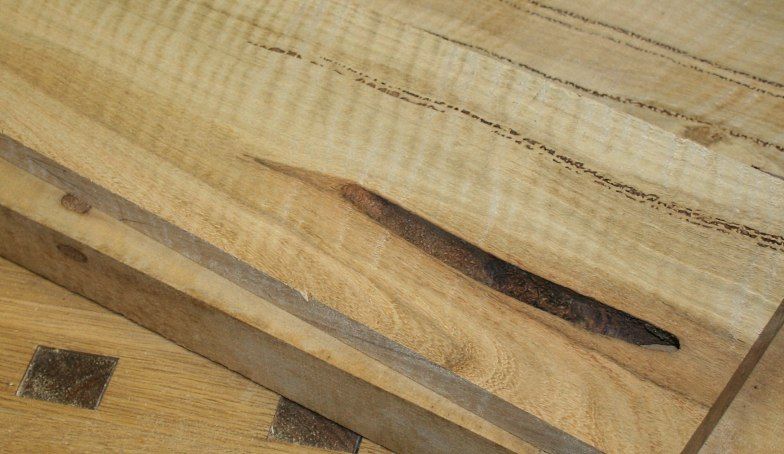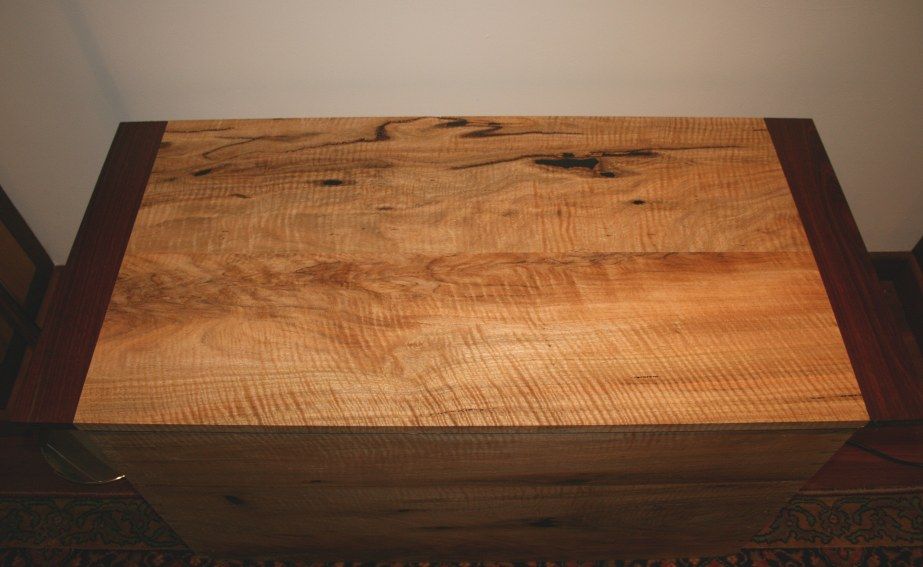By way of update, I include below a copy of a reply I made to Ellis Walentine at Wood Central, who described the difficulties in matching boards with curly figure. Bill Tindall suggested getting around this with bookmatching.
Thanks Ellis and Bill.
Ellis, I am sure that others, like I, first think of Jim Krenov when it comes to deciding what to build from a specific piece of wood .. letting the wood decide. Alternatively - and Warren made this point earlier - that one should choose the wood to match a project. He would not have selected Curly Marri for a project where a single board could have avoided the clashing of joined panels, or he would have gone with a wide panel that included all the faults. Bill, you suggested something similar (actually, you suggested spending more on wood! It might therefore surprise you to know that these Curly Marri boards in their rough sawn state cost me $450. Not cheap!).
The decision to cut away many (not all) the faults in the boards was partly because the faults were not attractive. While I am not a fan of 99% of live edge furniture, I do enjoy the natural faults that occur in most woods. Often I choose these deliberately and emphasise the fault as a feature. Mostly these involve a few faults that blend in with the surrounding figure. Curly marri is not like that. The faults are not attractive. They are just holes in the wood ...
Large, small ... lots of them.
So why use the wood at all? Because it is beautiful. It has potential just waiting to be unleashed. Curly Marri is quite rare. There is not much around here in Western Australia, where it grows. There is a fair amount of Marri, but Marri has the colouring without the charm, the warmth, and the figure. Marri is not expensive and is used a lot by local furniture makers. With all the voids filled in with black tinted epoxy, this furniture tends to look like a spotty Dalmation. The epoxy takes the place of figure.
What I wanted to do was try and join up the best of the wood and create boards that flowed together as naturally as possible. This is what we all try and do, so it is not an unusual factor. What it was, however, was an exercise in creativity. That is why I termed it 'painting in wood'.
I have essentially completed the lid, and I will show this shortly (try to avert your gaze!). There was enough to fashion the top out of two long boards, and I played around with these to get the best out of them. One option would have been to bookmatch one. I did not want to do so. The aim was to avoid too much symmetry in the wood as the design itself is very symmetrical.
What I have below is incomplete. I have not yet decided on proportions. The kist has been placed in an alcove (between built-in bookcases and in front of a large window). It will be storage and side table between two black leather seats. What I have to decide on is the width of the breadboard ends - do I make them narrower?
The Jarrah breadboard ends will link with a Jarrah base. How high I can make the base will determine whether I go ahead with my original design, or modify it. The plan is to build a base that sits proud of the outside and into the front of which I can build (hide) two drawers alongside one another. If you noticed before (or now) that the pins are different widths at the corners, this was so that there is support for a section around the base so that the dovetails are symmetrical along their length after the base is fitted. I'll leave the design of this to your imagination for now! Got to keep something back to surprise you later
Here is the top (at this stage) ...
And here is the front view - minus the base. The point here is to show the blending of the three boards ...
All comments and criticisms welcomed.
Regards from Perth
Derek









 Reply With Quote
Reply With Quote



